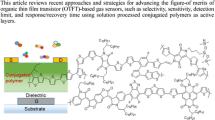Abstract
In this paper, bottom contact organic thin-film transistor (OTFT) gas sensors were prepared. Silicon dioxide (SiO2) and titanium/aurum (Ti/Au) were used as the insulating layer and the electrode for the device, respectively. The multi-walled carbon nanotubes (MWCNTs)/α-sexithiophene (α-6T) bilayer films were used as the active layer, and α-6T single layer sensitive film was also prepared for comparison purpose. The electrical and trace NO2-sening properties of these two OTFT gas sensors were tested and analyzed. The results showed that, the OTFT device based on MWCNTs/α-6T bilayer had obviously better electrical properties, better stabilities and higher NO2-sening response values than the device with α-6T single layer, in which both the carrier mobility (μ) and on/off current ratio enhanced two order of magnitude. The improved performance of bilayer OTFT can be explained that MWCNTs acted as highly conducting bridges connecting the crystalline terraces in the α-6T film. Threshold voltage (V T), carrier mobility, on/off current ratio and grid current which showed extremely similar variation trend as source-drain current, were optional parameters to reveal the gas-sensing characteristic of OTFT gas sensors. Morphology analysis showed that the special feature of MWCNTs had certain influence on the gas-sensing properties.
Similar content being viewed by others
References
Drury C J, Mutsaers C M J, Hart C M, et al. Low-cost all-polymer integrated circuits. Appl Phys Lett, 1998, 73: 108–110
Klauk H, Gundlach D J, Nichols J A, et al. Pentacene organic thin-film transistors for circuit and display plications. IEEE Trans Electron Devices, 1999, 46: 1258–1263
Jeong S H, Kim D J, Lee S, et al. Surface modification of novel organic-inorganic hybrid dielectrics using self-assembled monolayers. Solid State Phenom, 2007, 295: 124–126
Laurs H, Heiland G. Electrical and optical properties of phthalocyanine films. Thin Solid Films, 1987, 149: 129–142
Mabeck J T, Malliaras G G. Chemical and biological sensors based on organic thin-film transistors. Anol Bioanal Chem, 2006, 384: 343–353
Torsi L, Farinola G M, Marinelli F, et al. A sensitivity-enhanced field-effect chiral sensor. Nat Mater, 2008, 7: 412–417
Tanese M C, Fine D, Dodabalapur A, et al. Interface and gate bias dependence responses of sensing organic thin-film transistors. Biosens Bioelectron, 2005, 21: 782–788
Chang J B, Liu V, Subramanian V, et al. Printable polythiophene gas sensor array for lowcost electronic noses. J Appl Phys, 2006, 100: 014506-1–7
Zhu Z T, Mason J T, Dieckmann R, et al. Humidity sensors based on pentacene thin-film transistors. Appl Phys Lett, 2002, 81: 4643–4645
Jiang Y D, Tai H L, Du X S, et al. Parameter optimization of the OTFT gas sensor and its trace NO2-sensing properties. In: Proceedings of 2012 14th International Meeting on Chemical Sensors (IMCS). Nuremberg: AMA Service GmbH, 2012. 1126–1129
Fu S Q, Xie G Z, Tai H L, et al. α-sexithiophene based organic thin film transistors as gas sensor. In: Proceedings of 2010 International Conference on Apperceiving Computing and Intelligence Analysis (ICACIA). Chengdu: IEEE, 2010. 105–108
Jones B A, Ahrens M J, Yoon M H, et al. High-Mobility Air-Stable n-Type Semiconductors with Processing Versatility: Dicyanoperylene-3,4:9,10-bis(dicarboximides). Angew Chem, 2004, 166: 6523–6526
Hsieh G W, Li F M, Beecher P, et al. High performance nanocomposite thin film transistors with bilayer carbon nanotube-polythiophene active channel by ink-jet printing. J Appl Phys, 2009, 706: 106–123
Crone B, Dodabalapur A, Gelperin A, et al. Electronic sensing of vapors with organic transistors. Appl Phys Lett, 2001, 78: 2229–2232
Dresselhaus M S, Avouris P. Introduction to Carbon Materials Research. Heidelberg: Spring, 2001, 80
Kong J, Franklin N R, Zhou C, et al. Nanotube molecular wires as chemical sensors. Science, 2000, 287: 622–625
Lozzi L, Picozzi S, Armentano I, et al. Soft-x-ray photoemission spectroscopy and ab initio studies on the adsorption of NO2 molecules on defective multi-walled carbon nanotubes. J Chem phys, 2005, 123: 034702-1–6
Zhu Z T, Mason T, Dieckmann R, et al. Humidity sensors based on pentacene thin-film transistors. Appl Phys Lett, 2002, 81: 4643–4645
Baibarac M, Lapkowski M, Pron A, et al. SERS spectra of poly(3-hexylthiophene) in oxidized and unoxidized states. J Raman Spectrosc, 1998, 29: 825–832
Chan C K, Richter L J, Dinardo B, et al. High performance airbrushed organic thin film transistors. Appl Phys Lett, 2010, 96: 133304-1–3
Someya T, Dodabalapur A, Huang J, et al. Chemical and physical sensing by organic field-effect transistors and related devices. Adv Mater, 2010, 22: 3799–3811
Huang J, Miragliotta J, Becknell A, et al. Hydroxy-terminated organic semiconductor-based field-effect transistors for phosphonate vapor detection. JACS, 2007, 129: 9366–9376
Rella R, Serra A, Siciliano P, et al. Langmuir-Blodgett multilayers based on copper phthalocyanine as gas sensor materials: active layer-gas interaction model and conductivity modulation. Langmuir, 1997, 13: 6562–6567
Kendrick C, Semancik S. Doping effects and reversibility studies on gas-exposed-sexithiophene thin films. J Vac Sci Technol, A, 1998, 16: 3068–3075
Author information
Authors and Affiliations
Corresponding author
Rights and permissions
About this article
Cite this article
Tai, H., Zhang, B., Duan, C. et al. The effect of MWCNTs on the performance of α-sexithiophene OTFT device and its gas-sensing property. Sci. China Technol. Sci. 57, 1101–1108 (2014). https://doi.org/10.1007/s11431-014-5539-8
Received:
Accepted:
Published:
Issue Date:
DOI: https://doi.org/10.1007/s11431-014-5539-8




